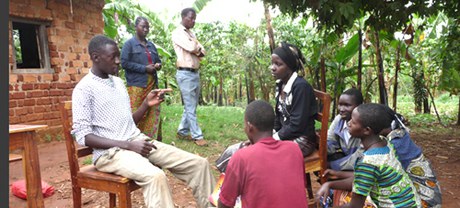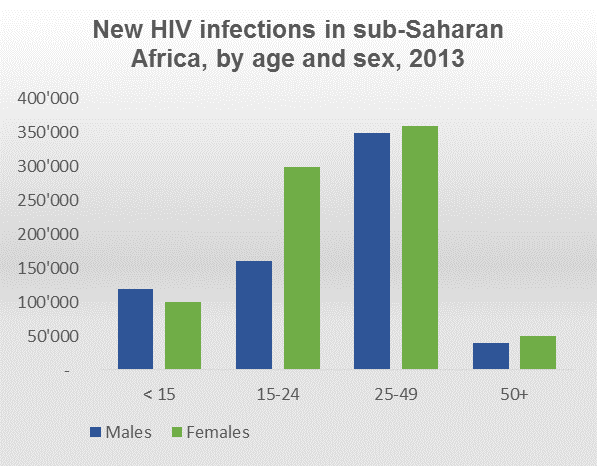
Topic of the Month: Adolescents living with HIV/Aids
In the light of the Medicus Mundi Switzerland Symposium on adolescent health “not without us!” the topic of this month is dedicated to adolescents living with HIV/Aids.
Despite the world wide decrease in HIV related deaths over the past years, death among adolescents aged 10 to 19 living with HIV has risen considerably1).
Today 4 million [3.6 million–4.6 million] young people aged 15 to 24 years live with HIV, 29% of whom are adolescents aged 15 to 19 years 2). Young women and adolescent girls are disproportionately vulnerable and at high risk. There are almost 380 000 [340 000–440 000] new HIV infections among adolescent girls and young women (10–24 years old) around the world every year2). Especially young women 15 to 24 years of age have a 50% higher chance to get infected with HIV compared to men the same age. In South Africa, women acquire HIV infection at least 5 to7 years earlier than men.
The high prevalence of adolescents HIV status especially among adolescent girls and young women point to the fact that the needs in this group has not been adequately addressed! (see figure below).

Source: UNAIDS 2013, estimates
Adolescents living with HIV face considerable challenges and have unique needs and vulnerabilities, as compared with young children and adults.
What are the challenges? Why have young people not been reached?
One of the major challenge young people face is the limited sexuality education and information on sexual and reproductive health and rights they receive. Young people must understand early in life the ongoing risk of contracting HIV and other sexually transmitted infections. The graphic below illustrates that young women aged 15 to 24 have a lower comprehensive knowledge of HIV/Aids compared to men the same age (W: 28%; M: 39%)3). Access to and the understanding of contraceptives among young people are limited. Condom use at last higher risk sex is also lower in young women compared to men (W: 37%; M: 57%) pointing to the fact that these women are often confronted with gender based violence and have limited success in negotiating condom use with their partner.

Ref: The Millennium Development Goals Report 2014 Report (s. MDG 6)
Especially adolescent living with HIV/Aids face major barriers accessing treatment tailored to their needs. Problematic laws and policies including parental consent laws hinder adolescents reaching HIV testing and counselling services. They also face more often stigmatisation and discrimination with inadequate access to health and social services or livelihood support.
As a result, questions are rapidly emerging as to how best to address these needs while also ensuring successful treatment, long-term retention, and optimal outcomes during the complex and often difficult transition from childhood to adulthood.
The symposium on adolescent health organised by Medicus Mundi Switzerland (05/11/2014) highlighted the need for youth friendly health services (YFHS) for adolescents. Besides having a health facility which is appealing to young people with flexible opening hours, specific times for adolescents, which ensures privacy and confidentiality it needs skilled health professionals: special competencies are required to communicate and treat adolescents4) 5) 6) 7). This also implies that health professionals have the right attitude and believes towards adolescents and counsel adolescents adequately to use condoms to protect themselves from acquiring HIV or other STIs.
In conclusion if the world wants to end the Aids epidemic all people affected by HIV especially young people need full and equitable access to life-saving treatment and prevention services! In Chandra Moullis (WHO) words “We cannot continue to do the same thing and expect change” (MMS Symposium, 2014): there is a high need for strong political leadership and technical consensus, partnership, secure funding and strong management, coupled with persistence and courage to address the challenges to better health for adolescents. (Foto: tdh)
Young people today – time to act now!
References
1) 90-90-90 An ambitious treatment target to help end the AIDS epidemic
UNAIDS, 2014
2) The Gap Report
UNAIDS, 2014
3) Millenium Development Goals Report 2014
UN, 2014
http://www.un.org/millenniumgoals/2014%20MDG%20report/MDG%202014%20English%20web.pdf
4) HIV and adolescents: Guidance for HIV testing and counselling and care for adolescents living with HIV
Guidance document
WHO, 2013
http://www.who.int/hiv/pub/guidelines/adolescents/en/
5) Adolescent HIV Care and Treatment, A Training Curriculum for Health Workers
ICAP, 2012
This innovative training package aims to empower multidisciplinary health workers to have the confidence and skills to provide comprehensive, youth-friendly HIV services that support adolescents’ healthy development, psychosocial well-being, retention, adherence, sexual and reproductive health, and eventual transition to adult HIV services. - http://icap.columbia.edu/resources/detail/adolescent-hiv-care-and-treatment
6) Adult and Adolescent ARV Guidelines
AidsInfo, offering Information on HIV/Aids Treatment, Prevention, and Research
http://aidsinfo.nih.gov/guidelines
7) Quality Assessment GUIDEBOOK
A guide to assessing health services for adolescent clients
WHO, 2009
http://whqlibdoc.who.int/publications/2009/9789241598859_eng.pdf
8) Young people today. Time to act now
UNESCO, 2013
http://unesdoc.unesco.org/images/0022/002234/223447E.pdf
Global guidance Brief Overview of HIV Interventions for Young People
http://www.who.int/hiv/pub/vct/adolescents/en/
9) Infographic: Young People Today
10) Get support?
Would you like to receive training for your organisation? If you are based in any of the following countries (Zimbabwe, Kenya, Nigeria, Ethiopia, Uganda, Mali, Senegal, Ghana) please contact our trainers and ask for more information about trainings and their training fees. Or contact: mgroenhof@stopaidsnow.org
The pilot project was succesfully evaluated, please find here a summary of the results.
